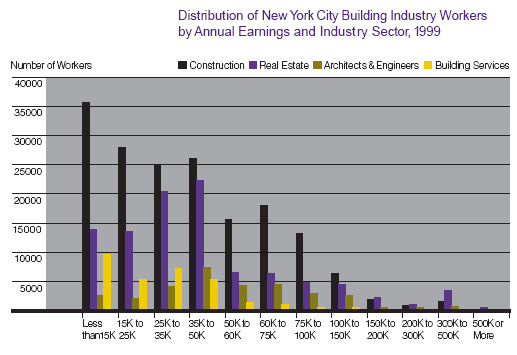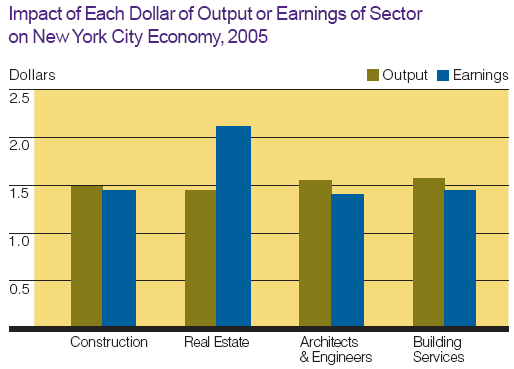Bedrock of the Economy: The New York Building Industry
Building A Stronger Economy
The recession that hit New York City in 2000 was exacerbated by the September 11 attacks in 2001. New York City lost thousands of jobsand the local government grappled with unprecedented budget deficits.
In the midst of the economic downturn, New York City’s building industry remained strong, countering the region’s recession and buoying the local economy by creating much-needed jobs, tax revenues and stimulating further development. And a strong industry was there to greet the recovery and help expand it further.
Today, the industry remains vital and is one of the keys to the City’s economic future.
Jobs
- In 2005, the industry accounted for more than 275,000 private sector jobs at approximately 31,500 firms.
- The total construction sector workforce, the largest employer in the industry, was last measured in 2005 at 123,200.
- The real estate sector accounts for about 90,300 additional jobs annually.
- Building services represent 31,500 jobs on average.
- Architectural and engineering services account for an average of 31,600 jobs.
- Not included in the industry’s workforce are another 30,000 construction workers employed by a wide array of non-construction firms and organizations involved in such fields as transportation, education, manufacturing and utilities, government and the Armed Forces

Industry Earnings
- On an annual basis, New York City building industry payrolls amount to nearly $14 billion.
- Heavy and civil construction reports the highest average annual wage at $68,900.
- Architectural and engineering services report the next highest wage at $68,000.
- Real estate workers earn $47,600 annually.
- Building service workers earn an average of $32,800.
Industry Spending and Revenue
- While the building industry accounts for eight percent of the City’s 3.6 million jobs, its contribution to Gross City Product (GCP) is considerably greater.
- Gross revenue for the entire industry exceeds $60 billion annually.
- The building industry represents about 25 percent of the GCP, if the rental value of owner occupied premises is included.
- Construction work alone, the largest sector in the industry, accounted for $27.4 billion of economic activity in New York City in 2005 (including payments to subcontractors).
- Real estate leasing and property management accounted for $25.9 billion of economic activity for New York City in 2005.

Indirect Impacts
- For each dollar of production by construction, real estate, design or building service sectors, an additional $0.50 on average is created in other City industries that purchase from or supply the various sectors. Thus, the $60.8 billion industry, as measured by gross revenues, actually stimulated nearly $90 billion of economic output in 2005.
- For each dollar of earnings paid to building industry employees, from $0.40 to $1.00 of additional earnings is paid to employees of other New York City industries.
- The $13.3 billion in earnings paid to building industry employees stimulated $21.7 billion of earnings in the New York City economy.
- Roughly 435,000 jobs were created throughout the City economy as a result of the direct and indirect effects of building industry efforts. Indirect jobs include those in law, accounting, concrete production, fabrication, catering, transportation, and consumer good sales to families of construction workers.



